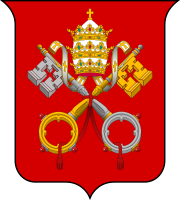Jata Takhta Suci
Jata Takhta Suci telah wujud sejak abad ke-14.[1][2] Ia diterapkan pada Bendera Kota Vatican yang lebih digunakan pihak Gereja Katolik pemerintah Kota Vatican untuk hubungan luar negeri kini.

Komponen sunting
Jata terdiri daripada dua komponen utama:
- dua bentuk kunci emas dan perak yang dikatakan sebagai amanah "kunci-kunci syurga" kurniaan Yesus Kristus kepada Simon Peter menurut Injil Matius:
Pengungkapan ini seterusnya diterapkan kepada perwakilan kuasa pejabat kepausan yang dipertanggungjawabkan "melonggarkan dan mengikat" agama Kristian."Saya akan memberikan anda kunci-kunci kerajaan syurga, dan apa sahaja yang kamu "ikat" di Bumi akan terikat di syurga, dan apa sahaja yang kamu "longgar" di Bumi akan dilepaskan di syurga."
— Injil Matius ayat 19 - Tiga mahkota membentuk suatu tiara besar mewakili tiga kuasa Paus sebagai "bapa raja-raja", "gabenor dunia" dan "Pendeta Kristus". Salib emas pada monde (glob) yang terletak di tiara melambangkan kedaulatan Yesus.
Rujukan sunting
- ^ "A red shield bearing two white crossed keys, and surmounted by the tiara, is to be seen in a window of the cathedral of Bourges accompanying the achievements of the anti-popes Clement VII and Benedict XIII, and other examples of these tinctures are to be found in manuscripts dating from the time of the former of these anti-popes and from that of Nicholas V, in a series of shields painted on the ceiling formerly in the church of San Simone at Spoleto (ca. 1400), in the 15th-century glass in the cathedrals of York and of Carpentras, in various 15th-century books of arms both English, German, and Italian, as well as in Martin Schrot's book of arms which is as late as 1581." Donald Lindsay Galbreath, A Treatise on Ecclesiastical Heraldry (W. Heffer and Sons, 1930).
- ^ "From the beginning of the 14th century, the two crossed keys constitute the arms of the papacy. The field of the shield is generally gules (red) and the cord is azure (blue). Most often the key placed in bend is gold and the one placed in bend sinister, silver; sometimes they are both gold, or, less often, silver" (Michel Pastoureau, "Keys" in Philippe Levillain, The Papacy: An Encyclopedia (Routledge 2002 ISBN 9780415922302), vol. 2, p. 891).